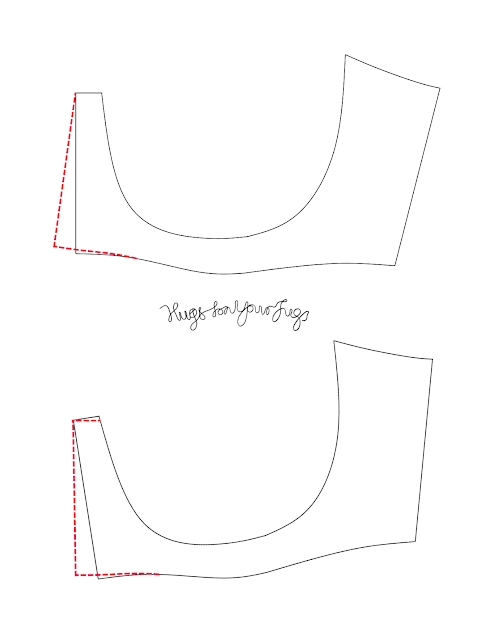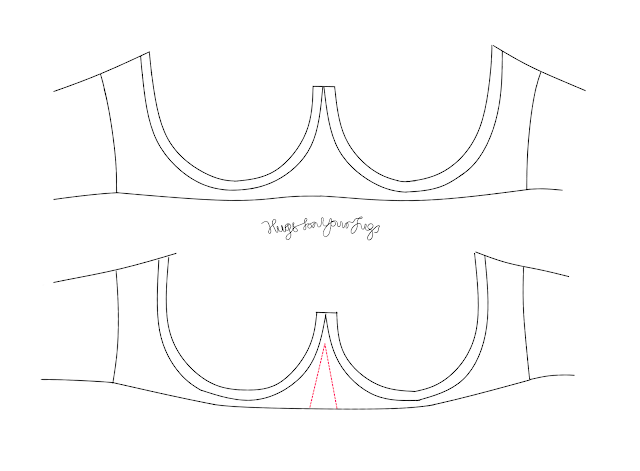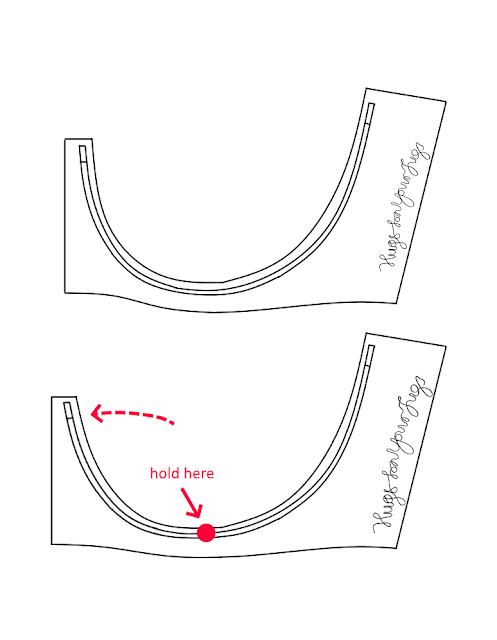2 Ways to Widen the Lower Gore - Wire Spring vs Wire Rotation
Widening the lower gore (aka the lower bridge) is a common alteration for those with a splayed root shape, but the techniques in this post can also be used to turn a regular wire into a plunge wire. Here's two ways to widen the lower gore, each with their own advantages and disadvantages.
Wire Rotation
The wire rotation method is a simple alteration, made by literally adding a triangle to the lower gore to widen it. This is the alteration most people talk about when recommending widening the lower gore, such as in this post by Cloth Habit.
The alteration is very easy, you just add as much width as you want (half of the total width increase of course) and make sure the top and bottom off the gore are sitting at 90 degrees to your new centre gore line, and off you go.
 |
| The standard method of widening the gore by wire rotation |
You can also test out this alteration on a toile/fitting band by slicing it up the middle and patching it with a triangular piece of fabric.
You can see that the entire cradle gets rotated when you make this alteration, and thus the cup inside will be too.
Advantages
- Super easy to test out and implement
- This alteration can be used to reduce lower cup wrinkles, especially wrinkles in the centre front.*
Disadvantages
- Cup rotation may change fit of the cup substantially
- The outer edge of the wires can become very tall and poke your armpits - especially with vertical wires, which may start to curve inwards at the tip
- The band length increases by the total width increase, so you may need to correct for that to maintain good support
- The geometry of the band changes, and this can have an impact on the tension distribution along the top and bottom elastics of the band
Also this method can lower the gore quite a lot, which may or may not be an intended side effect.
Inner Wire Spring
This method is lesser known but useful for when you don't want to change the cup rotation or change the height at the armpit. It is also sometimes known as "double spring", but you don't necessarily need to spring the outer edge of the wire to spring the inner edge.
You do it by holding the base of the wire and springing it to the desired amount in the middle, then using that wire trace to construct a new cradle (make sure to include the spring you want on the outer edge of the wire as well). You can use the outer half of your original cradle to make this easier.
You can also test this out with a patch too, though it's more fiddly. Cut the middle of your bra as before, put pressure on the lower wires and pull them outwards, then pin a patch of fabric around the hole created in the middle, take it to the machine and sew it.
Advantages
- Does not cause any cup rotation so the fit of the cups is affected less
- Outer wire height remains the same
- Gore height not substantially changed with a small spring, but with enough spring you can lower the gore substantially (to turn a regular wire into a plunge wire)- so overall you have more control over the gore height.
- No impact on band fit
Disadvantages
- Wire may not easily spring as far as you need it to
- Harder to do correctly, especially if you're patching an existing toile/fitting band
- Wire and bridge under more stress when worn, potentially stretching the cradle fabric and wearing through the materials faster
- The band length increases by the total width increase, so you may need to correct for that to maintain good support
- Overspringing the wire at the centre front could potentially cause the gore to dig in
If you liked this post, be sure to follow me for email updates whenever I post a new one! If you really liked this post, donate to my Ko-fi for extra content!
* Some say this is because the wires fit your root shape better but I'm not sure I agree - I think it may have more to do with the entire rotation of the cup and, in particular, the changing relationship between the neckline and the strap supporting the inner cup more. I'm not 100% sure on this though so don't take it as gospel.




Here is a thought I would be interested in exploring: How would the opposite affect wire spring? (meaning if the gore was narrowed in the lower part so that the wires are angled slightly and broight closer together qithout overlapping them)
ReplyDelete